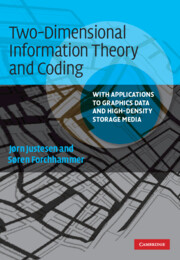 Two-Dimensional Information Theory and Coding
Two-Dimensional Information Theory and Coding Published online by Cambridge University Press: 05 June 2012
Introduction
In the previous chapters we have presented the basic concepts of information theory, source coding, and channel coding. In Chapters 1−3 we have followed traditional information-theory terminology in distinguishing between sources, which produce information, and channels, which are used for transmission (or storage) of information. In many current forms of communication information passes through multiple steps of processing and assembly into composite structures. Since in such cases it can be difficult to make a distinction between sources and channels, we use the neutral term information medium to refer to structures, whether physical or conceptual, that are used for storing and delivering information. In short form the terms medium and media are used. The diverse forms of electronic media may serve as examples of the composite objects we have in mind and the range of meanings of the term. As a specific case one can think of a two-dimensional (2-D) barcode printed on an advertising display so that it can be read by a cell-phone camera and used as a way of accessing the website for the business.
In the case of highly structured composite objects we shall make no attempt to directly apply concepts like entropy or capacity. Instead we limit our applications of information theory tools to more well-defined components of such objects in digital form. The present chapter discusses how 2-D media can be described in the light of these concepts, and how the various tools can be used in such applications.
To save this book to your Kindle, first ensure [email protected] is added to your Approved Personal Document E-mail List under your Personal Document Settings on the Manage Your Content and Devices page of your Amazon account. Then enter the ‘name’ part of your Kindle email address below. Find out more about saving to your Kindle.
Note you can select to save to either the @free.kindle.com or @kindle.com variations. ‘@free.kindle.com’ emails are free but can only be saved to your device when it is connected to wi-fi. ‘@kindle.com’ emails can be delivered even when you are not connected to wi-fi, but note that service fees apply.
Find out more about the Kindle Personal Document Service.
To save content items to your account, please confirm that you agree to abide by our usage policies. If this is the first time you use this feature, you will be asked to authorise Cambridge Core to connect with your account. Find out more about saving content to Dropbox.
To save content items to your account, please confirm that you agree to abide by our usage policies. If this is the first time you use this feature, you will be asked to authorise Cambridge Core to connect with your account. Find out more about saving content to Google Drive.